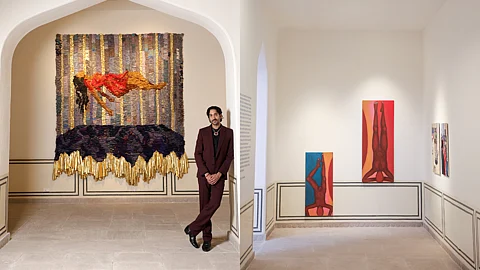
- HOMEGROWN WORLD
- #HGCREATORS
- #HGEXPLORE
- #HGVOICES
- #HGSHOP
- CAREERS
- ABOUT US
- CONTACT US

Since opening in December 2024, the Jaipur Centre for Art has fast emerged as one of the most interesting and influential spaces for contemporary arts in India. With 'Non-Residency', an exhibition curated by LA-based Indian-American gallerist Rajiv Menon, the centre is attempting something that, even at first sight, feels long overdue: positioning contemporary South Asian diasporic artists not as parallel to Indian modern art history, but as a continuation of the same generative force. Housed within the historic interiors of the Friends of the Museum building in Jaipur City Palace, the exhibition marks the first exhibition at the palace curated by a singular gallery, and Menon's first curatorial project in India — a cross-continental collaboration exploring the cultural, aesthetic, and psychological dynamics of the South Asian diaspora.
Menon's decision to foreground fourteen South Asian and diasporic artists like Rajni Perera, Suchitra Mattai, Melissa Joseph, and Shyama Golden in his first curatorial project in the country speaks to a gap in India's modern art discourse. Indian modernism, shaped by artists' collectives like the Progressive Artists' Group emerged as a response to post-independence nationalism and global modernist currents in the latter half of the 20th century. While émigré artists existed and worked within the broader modernist movement, their work was often relegated to the peripheries and discussed as parallel rather than integral — as cultural "export" rather than embedded within the national narrative. The result was an art historical canon which treated diasporic artists' work as derivative or hybrid.
Non-Residency challenges that hierarchy. By bringing these diasporic artists to Jaipur, the exhibition stages a symbolic homecoming. In Menon's curatorial framing, the diaspora defines itself, not as a diluted echo of the homeland, but a complex, adaptive expression of identity shaped by immigration, exile, indentureship, and intergenerational negotiation. The works on view — spanning mediums like painting, sculpture, and textile — do not claim authenticity; instead, they embrace the uncanny qualities that emerge when cultural inheritances are reimagined in foreign contexts. This positions diasporic art as a site of innovation, precisely because of its displacement, resonating with broader postcolonial debates about hybridity and cultural fluidity.
In acknowledging the diaspora as a vital force in shaping global perceptions of Indian art, Non-Residency nudges the conversation towards a more inclusive modern art history, one that understands movement, absence, and return as core to the subcontinent's creative evolution.
Whether this moment marks a systemic shift or remains a rarefied gesture will depend on how institutions like JCA build on such initiatives. If Non-Residency is to be more than a celebratory gesture, it must open pathways for sustained and sustainable cultural exchange — where artists are free to move between 'resident' and 'non-resident' without the history of hierarchy, and where India's art history finally acknowledges that its story has always been written in more than one place at a time.
